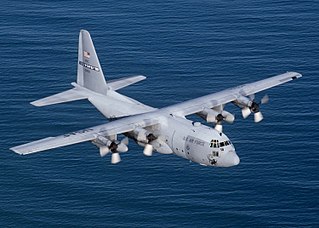
The Lockheed C-130 Hercules is an American four-engine turboprop military transport aircraft designed and built by Lockheed. Capable of using unprepared runways for takeoffs and landings, the C-130 was originally designed as a troop, medevac, and cargo transport aircraft. The versatile airframe has found uses in other roles, including as a gunship (AC-130), for airborne assault, search and rescue, scientific research support, weather reconnaissance, aerial refueling, maritime patrol, and aerial firefighting. It is now the main tactical airlifter for many military forces worldwide. More than 40 variants of the Hercules, including civilian versions marketed as the Lockheed L-100, operate in more than 60 nations.
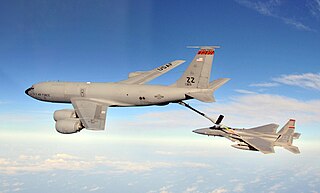
The Boeing KC-135 Stratotanker is an American military aerial refueling tanker aircraft that was developed from the Boeing 367-80 prototype, alongside the Boeing 707 airliner. It has a narrower fuselage and is shorter than the 707. Boeing gave the aircraft the internal designation of Model 717. The KC-135 was the United States Air Force's first jet-powered refueling tanker and replaced the KC-97 Stratofreighter. The KC-135 was initially tasked with refueling strategic bombers, but it was used extensively in the Vietnam War and later conflicts such as Operation Desert Storm to extend the range and endurance of US tactical fighters and bombers.
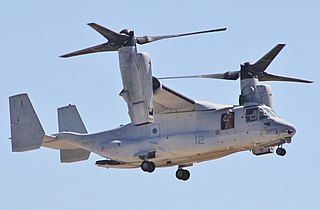
The Bell Boeing V-22 Osprey is an American multi-mission, tiltrotor military aircraft with both vertical takeoff and landing (VTOL) and short takeoff and landing (STOL) capabilities. It is designed to combine the functionality of a conventional helicopter with the long-range, high-speed cruise performance of a turboprop aircraft.
This is a list of aviation-related events from 1980.

The Sikorsky CH-53E Super Stallion is a heavy-lift helicopter operated by the United States military. As the Sikorsky S-80, it was developed from the CH-53 Sea Stallion, mainly by adding a third engine, adding a seventh blade to the main rotor, and canting the tail rotor 20°. It was built by Sikorsky Aircraft for the United States Marine Corps. The less common MH-53E Sea Dragon fills the United States Navy's need for long-range minesweeping or airborne mine countermeasures missions, and performs heavy-lift duties for the Navy. The Sikorsky CH-53K King Stallion, which has new engines, new composite rotor blades, and a wider aircraft cabin, is set to replace the CH-53E.

The Boeing C-97 Stratofreighter was a long-range heavy military cargo aircraft developed from the B-29 and B-50 bombers. Design work began in 1942, the first of three prototype XC-97s flew on 9 November 1944, and the first of six service-test YC-97s flew on 11 March 1947. All nine were based on the 24ST alloy structure and Wright R-3350 engines of the B-29, but with a larger-diameter fuselage upper lobe and they had the B-29 vertical tail with the gunner's position blanked off. The first of three heavily revised YC-97A incorporating the re-engineered wing, taller vertical tail and larger Pratt & Whitney R-4360 engines of the B-50 bomber, flew on 28 January 1948 and was the basis of the subsequent sole YC-97B, all production C-97s, KC-97s and civilian Stratocruiser aircraft. Between 1944 and 1958, 888 C-97s in several versions were built, 811 being KC-97 tankers. C-97s served in the Berlin Airlift, the Korean War, and the Vietnam War. Some aircraft served as flying command posts for the Strategic Air Command, while others were modified for use in Aerospace Rescue and Recovery Squadrons (ARRS).

The CH-53 Sea Stallion is an American family of heavy-lift transport helicopters designed and built by the American manufacturer Sikorsky Aircraft.
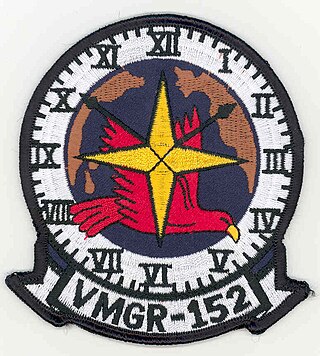
Marine Aerial Refueler Transport Squadron 152 (VMGR-152) provides aerial refueling service to support Fleet Marine Force (FMF) air operations; and provides assault air transport of personnel, equipment, and supplies. The squadron, known as the "Sumos", flies the fixed-wing Lockheed Martin KC-130J aircraft. VMGR-152 is stationed at Marine Corps Air Station Iwakuni, Iwakuni, Japan and is part of Marine Aircraft Group 12 (MAG-12) and the 1st Marine Aircraft Wing.

Marine Aerial Refueler Transport Squadron 352 (VMGR-352) is a United States Marine Corps KC-130J squadron. They are a part of Marine Aircraft Group 11 (MAG-11), 3rd Marine Aircraft Wing and provide both fixed-wing and rotary-wing aerial refueling capabilities to support Fleet Marine Force (FMF) air operations in addition to assault air transport of personnel, equipment, and supplies. The squadron, known as the "Raiders" is stationed at Marine Corps Air Station Miramar, California.
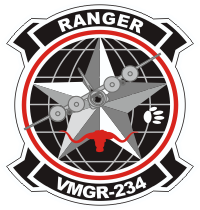
Marine Aerial Refueler Transport Squadron 234 (VMGR-234) is a reserve United States Marine Corps KC-130J squadron. They are a part of Marine Aircraft Group 41 (MAG-41), 4th Marine Aircraft Wing and provide both fixed-wing and rotary-wing aerial refueling capabilities to support Marine Forces Reserve air operations in addition to assault air transport of personnel, equipment, and supplies. The squadron, known as the "Rangers" is stationed at Naval Air Station Joint Reserve Base Fort Worth, Texas.

Marine Aerial Refueler Transport Squadron 452 (VMGR-452) was a reserve United States Marine Corps cargo squadron that previously flew the Lockheed Martin KC-130J. The squadron fell under the command of Marine Aircraft Group 49 (MAG-49) and the 4th Marine Aircraft Wing. The squadron, known as the "Yankees", was stationed at Stewart Air National Guard Base, New York.

Marine Aerial Refueler Transport Squadron 252 (VMGR-252) is a United States Marine Corps KC-130J squadron. They are a part of Marine Aircraft Group 14 (MAG-14), 2nd Marine Aircraft Wing and provide both fixed-wing and rotary-wing aerial refueling capabilities to support Fleet Marine Force air operations in addition to assault air transport of personnel, equipment, and supplies. The squadron, known as "Otis" is stationed at Marine Corps Air Station Cherry Point, North Carolina. It also has the distinction of being the oldest continually active squadron in the Marine Corps.
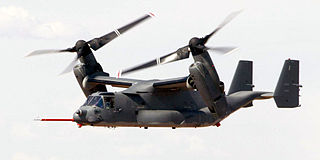
The Bell Boeing V-22 Osprey is an American military tiltrotor aircraft with an accident history that has generated controversy over its perceived safety. The aircraft was developed by Bell Helicopter and Boeing Helicopters; the companies partner in its manufacture and support.

The Lockheed Martin C-130J Super Hercules is a four-engine turboprop military transport aircraft. The C-130J is a comprehensive update of the Lockheed C-130 Hercules, with new engines, flight deck, and other systems.
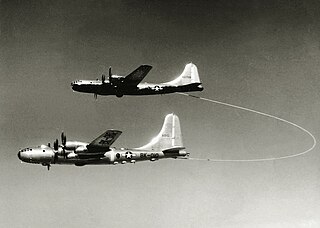
Lucky Lady II is a United States Air Force Boeing B-50 Superfortress that became the first airplane to circle the world nonstop. Its 1949 journey, assisted by in-flight refueling, lasted 94 hours and 1 minute. The plane later suffered an accident, and today only the fuselage is preserved.

The Lockheed MartinKC-130 is a family of the extended-range tanker version of the C-130 Hercules transport aircraft. The KC-130J is the latest variant operated by the United States Marine Corps (USMC), with 48 delivered out of 79 ordered. It replaced older KC-130F, KC-130R, and KC-130T variants for aerial refueling. USMC reserve unit, VMGR-452 operated 12 KC-130T aircraft until May 2021; this was the last USMC reserve unit that operated the legacy KC-130s, completing the corps' transition to the more advanced Super Hercules.

A United States Marines Corps (USMC) Lockheed KC-130F Hercules, ferrying a group of US marines back to South Vietnam from rest-and-relaxation leave in then-British Hong Kong, crashed on take-off, causing a total of 59 deaths out of all 71 on board the aircraft on August 24, 1965.

On 9 December 2019, a Chilean Air Force Lockheed C-130 Hercules military transport aircraft crashed in the Drake Passage while en route to Base Presidente Eduardo Frei Montalva, a Chilean military base on King George Island in Antarctica.


















